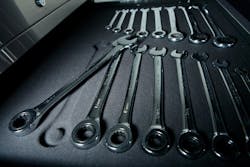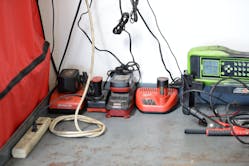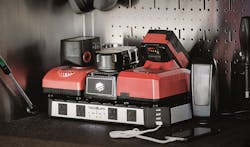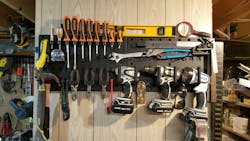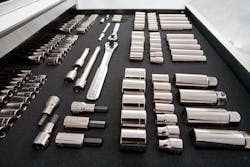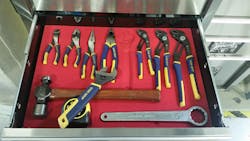Editor's Note: This article was orginally published March 4, 2016. Some of the information may no longer be relevant, so please use it at your discretion.
At first glance, tool organization may not seem that important. But, time is money. This is especially true for technicians. Staying organized becomes increasingly important because it helps optimize workflow, overall productivity and even safety.
Katy Sanchez, vice president of sales for Ernst Mfg. says technicians can waste a lot of time digging through toolboxes trying to find a particular tool. She adds that tool storage accessories, such as the company's Wrench Gripper and Socket Boss, are good for tool management.
"At the end of the day, if you open your toolbox drawer and see all of your tools are accounted for, you know all of your tools are put away and ready for the next day. You can see you don’t have missing tools. You don’t have to replace tools, if you can track what you have."
Sanchez says, "You can spend a lot of money on the toolbox as-is, but it doesn’t help if you can’t find your tools."
"Distributors should look at their customer’s shop, garage and/or assembly line to offer solutions to create organization and efficiency," says Executive Vice President of Hansen Global, Julie Thielbar.
Thielbar explains tool organization is also extremely important in to help maximize workspace. She says that, because technicians need to quickly locate the tools required for their job to increase productivity, an employee's ability to display and locate their tools ensures accountability and safety.
Also, think about technicians who have to replace lost tools because they are disorganized, says Mel Young, president of ToolLodge. The cost of replacing a socket may not be that much in terms of time and money, but if you leave a socket in an engine compartment of a car... the consequences of that could actually be devastating." She says, "Not only do you improve efficiency and prevent tool loss, you can mitigate risk and damage by foreign objects."
Now trending
There are many tool storage accessories available on the market today ranging from wrench and socket trays to foam inlays for toolboxes and everything in between. What are the technicians looking for? Customization, says Ernst's Sanchez.
"I think technicians spend a lot of time setting up their toolbox to their set of tools. That is hard to do for organizers that are pre-defined. There is no flexibility in that respect," explains Sanchez.
She emphasizes the importance of customization for tool organization, and having many options available. She adds, "Customers want something they can make unique to their own set of tools because every set of tools is completely different."
Not only are there customizable accessories for sets of tools, but companies now offer tool storage accessories designed specifically to customize the workspace. ToolLodge offers customizable foam inlays for toolboxes. Young says if technicians choose accessories that are not customizable, tools outside of the set become "orphans."
Other products, like the Hansen Global ToolHanger, a plastic organization board with twisting and locking hangers to organize, display and hang tools, allows users to customize and maximize storage space. Hansen Global's Thielbar says, "This new interlocking board hangs horizontally and vertically to create unlimited finished sizes."
Additional accessory options
Look for products that bring a little something extra to the table for your customers. Tech-Life's The Grid not only helps technicians keep power tools organized, but it also provides additional power outlets and USB plugins where power is typically in short supply.
"I see techs struggle with power delivery, said Nick Mazza, CEO and co-founder of Tech-Life. "No matter how new or old the shop, power outlets seem to be in high demand. Bringing power to the toolbox has always been a problem for technicians."
Mazza says that The Grid helps technicians save space, as well.
"Essentially, the technician would have had the tools on his workbench or toolbox. We’re putting the grid under the power tools, utilizing a similar footprint with an additional nine outlets and four USB cords."
Ask questions
Are you servicing a new technician, a new shop, or are you new to your route? Each technician has unique tool storage needs. As a distributor, it's up to you to gauge those needs and determine tools to help accomplish their specific goals.
Here are some questions you can ask to determine a need for any tool storage accessory:
- Are you looking for a way to streamline your shop?
- How much time do you spend looking for (and retrieving) tools throughout the day?
- Do you have to replace hand tools because they are misplaced?
- Do you want a tool organization system that will make your employees or yourself more efficient?
- Do you need to maximize your storage space?
Give demonstrations
Did you just sell a socket or wrench set to a customer? If so, ask them how they plan to store it.
"The Ernst Wrench Gripper and Socket Boss are good "accessory items," says Sanchez. "It's often a good add-on. "That's a good place to organize and display (a distributor's) own tools for selling."
Tech-Life’s Mazza shares insights on how to sell The Grid, which can also be translated to other tool storage accessory options. He says the best way to sell is to ask the technician what they’re currently using as a tool storage solution.
“They’re going to be using something that is not performing to the standard it should be. I think that the technician’s mentality is that there is a tool for every job and the average technician does not have the right tool for this job. You can then demonstrate the benefits of this product.”
To demonstrate the effectiveness of Tech-Life's The Grid, Mazza says show the tool in-use either by plugging cordless tools and organizing them on a shelf or toolbox on your truck, or take the product into the shop and show a technician the transformation of his own station. Mazza stresses the importance of plugging the tools in.
"The more things you plug in, the more impressive it gets. Once you can see how many things you can give power to, the value proposition starts to become obvious to the user."
Distributors should also be mindful of each tool's limitations. ToolLodge's Young says this product can be displayed in a shop or on a truck, as well, but that it doesn't work well in environments where there is a lot of movement. If distributors set up foam boards on the truck, they should be set up inside a drawer.
"In addition to having the drawer set up with a display of tools, have a couple of samples on hand where technicians can make their own impressions." She adds, "We have about 20 to 25 percent repeat .business. Once a customer looks at it, they will know if it is a fit for them. Get the product in the c ustomers hands. Customers who like it, want more."
